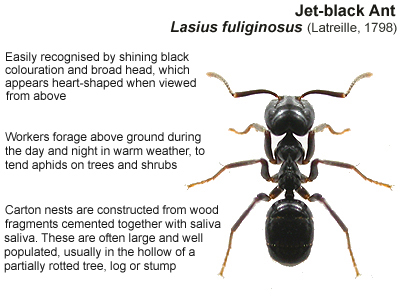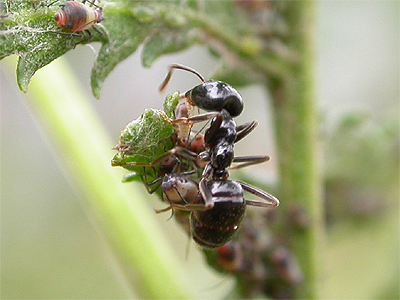

| The return of the Ant Lasius fuliginosus to Nottinghamshire |
| After an absence of just
over 110 years, the distinctive black Ant Lasius
fuliginosus (Latreille, 1798) was rediscovered in
Nottinghamshire at Netherfield Lagoons in 2018. Reappearing in the county was always thought unlikely, in view of its reported decline in recent years. However, news of the discovery at Netherfield Lagoons by Tony Kavanagh, was forwarded to us by Peter Smith in early September, who informed us that workers were indeed found tending Aphids on Tansy (Tenacetum vulgare). Previous Nottinghamshire records Last seen in Nottinghamshire at Sherwood Forest in 1907 (Donisthorpe), it seems there has never been any other records of Lasius fuliginosus and it was presumed to have long since become extinct in the county - if indeed it ever really was a regular part of our resident fauna a century ago. |
 |
|
| .... | ||
| Nationally there seems to be some evidence of a decline from more northern and central counties of the UK, although it is never really a common Ant wherever it is found. It seems that nests can be quite isolated and are usually recorded at low densities per acre/hectare. Apparently, they can also be easily missed, despite workers forming long, conspicuous trails leading from the nest and up to the higher branches of trees and shrubs in search of food. So it is quite possible that other Lasius fuliginosus nests may well have been present undetected in the lower reaches of the Trent Valley for a number of years. | ||
| .... |
 |
Sometimes known as the
Jet Ant, or Jet-black Ant, Lasius fuliginosus workers
tend Aphids and their diet largely consists of the
honeydew excreted by them. We identified those Aphids
being tended at Netherfield as being Pink Tansy Aphids (Metopeurum
fuscoviride) and these were quite fiercely guarded
by the tending workers, though because the worker jaws
are relatively weak, biting attempts on the human hand
are futile. Nesting biology One of the reasons Lasius fuliginosus has been so rare in Nottinghamshire, is probably down to its rather complex nesting biology and reliance on other (equally as rare) species being present. Lasius fuliginosus is a temporary social parasite. This means young queens are only being able to form new colonies, by first entering and then taking over the nests of either Lasius mixtus or Lasius umbratus, then eventually killing the host queen after gaining acceptance. |
| .... | ||
| What is
interesting about the 1907 Sherwood Forest record, is
that neither of the two host species have ever been
recorded there, despite the available habitat seeming
more than suitable. We searched for a number of years for
Lasius fuliginosus and both its host species
at Sherwood, but only ever succeded in finding the
rare spider Mastigusa macrophthalma. Mastigusa macrophthalma is a dull, unicolourous spider with few discernable markings and is known to have strong associations with Lasius fuliginosus, Lasius brunneus and Lasius umbratus and has apparently been found within their nests. If L. brunneus or L. umbratus were ever present at Sherwood then they went unrecorded, but yet the spider survived and in good numbers too. But there is an additional problem to the complex nesting biology of Lasius fuliginosus, as both Lasius mixtus and Lasius umbratus are also temporary social parasites of other Lasius species, relying on the same method of colony foundation as Lasius fuliginosus. This in itself is potentially very interesting from a Nottinghamshire point of view, as Lasius mixtus has (to our knowledge) never been recorded in Nottinghamshire before and the county's only record of Lasius umbratus refers to two (post Nuptial flight) queens found at Tollerton in 1908. So as Lasius fuliginosus is at Netherfield, then there is the very likely possibility that either Lasius mixtus and Lasius umbratus (or both) are also present in the Netherfield area. Finding either species would certainly represent another substantial county record. |